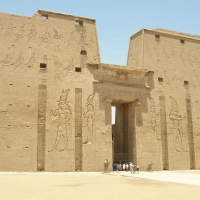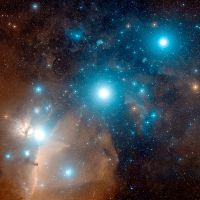
Small Magellanic Cloud Galaxy
This neighbor galaxy orbits the Milky Way about 200,000 light-years away. Far more distant galaxies are sprinkled around the picture’s edge. Magellan used SMC to navigate across the oceans.
Here is a simple question that even a kindergartner can understand.
But no one alive, not even the smartest scientist, can answer this question!
How many stars are there?
Galaxies
A galaxy is a gravity-bound system of stars. Dwarf galaxies range from a thousand stars to several billion stars. Supergiant galaxies have one hundred trillion stars. Our Milky Way galaxy is considered medium-large, estimated to contain between 100 billion and 400 billion stars.
The Small Magellanic Cloud with several hundred million stars is one of more than 20 dwarf galaxies orbiting the Milky Way. The Large Magellanic Cloud with 30 billion stars is another dwarf galaxy orbiting the Milky Way.
In 2021, it was estimated that there are at least 200 billion (200,000,000,000) galaxies in the observable universe. This estimate was based on NASA’s New Horizons space probe.
Last year astronomer David Kornreich of Ithaca College roughly estimated 10 trillion galaxies in the universe averaging 100 billion stars per galaxy to calculate there are one septillion (1,000,000,000,000,000,000,000,000) stars in the universe. But Kornreich emphasized that number is likely a “gross underestimation.” He thinks more detailed future looks far into the universe will show even more galaxies and hence far more stars.
How many stars are there? It is a simple question, but no man alive can answer it!
James Webb Space Telescope
In order to learn more about stars and galaxies, the James Webb Space Telescope (JWST) was rocket-launched into space in December 2021.
The telescope cost $10 billion. It transmits data back to Earth via the microwave band of the electromagnetic spectrum.
JWST is the most powerful telescope ever sent into space. It can view objects that are too faint or too distant to be seen with the Hubble Space Telescope as JWST is about 100 times more powerful. JWST was named for James E. Webb (1906–1992) who served as the Administrator of NASA from 1961 to 1968.
JWST orbits a point in space known as the Sun–Earth L2 Lagrange point about 930,000 miles beyond Earth’s orbit around the Sun. By way of comparison, the Hubble Space Telescope orbits 340 miles above Earth’s surface, and the Moon is roughly 250,000 miles from Earth. JWST orbits the Sun in synchrony with the Earth, maintaining a fairly constant distance from Earth.
Will JWST answer the question: How many stars are there? No, it will not. It may improve man’s estimate, but it will not give an exact figure.
Only the Great Creator Himself knows how many galaxies and stars inhabit the universe. He knows the count of the stars and the name of each one. Very possibly there are far more stars burning in the unobservable universe than in the portion we can observe.
He counts the number of the stars; He gives names to all of them. Great is our Lord, and abundant in strength; His understanding is infinite. (Psalm 147:4-5)
Lift up your eyes on high and see who has created these stars, the One who leads forth their host by number, He calls them all by name. Because of the greatness of His might and the strength of His power not one of them is missing. (Isaiah 40:26)
It is intriguing that in Psalm 147, right before the verses quoted above about numbering and naming the stars, the Psalmist says the Lord heals the brokenhearted and binds up their wounds. And shortly thereafter he says the Lord gives to the beast its food, and to the young ravens which cry. (Psalm 147:3-9)
The same all-wise Designer who fashioned galaxies from nothing, who misses no detail in the vastness of deep space, makes specific provision for baby birds and broken-hearted humans.
How does a rational person react to this grandeur and this grace? Psalm 147 uses an “awe sandwich.” Like enthused fans at a championship parade, we must cheer and sing the fame of our Marvelous Creator (verses 1,5,7,12,20). Then we meditate on the astounding attributes of our great God. And the last layer in the sandwich is cultivating the fear of the Lord plus reverent trust:
The Lord favors those who fear Him,
Those who wait for His lovingkindness. (Psalm 147:11)
Recently astounding discoveries have emerged using the James Webb Space Telescope. Next week’s blog Inconvenient Galaxies will discuss them.

Questions to Ponder
1. How can the vastness and complexity of the starry host enrich worship of Yahweh the Great Creator?
2. What evidence did you see today of God’s tenderness and care toward his vulnerable creatures?
Share your thoughts on these questions in the comments below. It could encourage or help another reader.
For Christ and His Kingdom.
Alere Flammam Veritatis.
Soli Deo Gloria.
Read the sequel:
Inconvenient Galaxies
Subscribe – Don’t miss future blog posts!
Click the sidebar’s “SUBSCRIBE” button to follow the
Bible-Science Guy Blog. You’ll automatically receive
new posts free by email. Click SUBSCRIBE NOW!
Click Best of Bible-Science Guy for lists of the best Bible-Science Guy posts of each year.
Click Bible-Science Guy Table of Contents for a list of all blog posts starting in October 2007.
©William T. Pelletier, Ph.D.
“contending earnestly for the faith”
“destroying speculations against the knowledge of God”
“for the defense of the gospel”
(Jude 1:3; 2 Cor 10:5; Phil 1:16)
Wednesday March 15, 2023 A.D.
The heavens declare the glory of God, and the sky above proclaims His handiwork. (Psalms 19:1)
Disclaimer: BibleScienceGuy has no control over any advertising that may appear and receives no payment or consideration for it. Ads & “Related” links come from WordPress, not from BibleScienceGuy.





























How many stars are there? God knows. However, the number is not infinite (only God is infinite). God created all the stars (celestial objects) on Day Four and He ceased from creating on Day Seven; so no new stars are being created regardless of what scientists may claim.
Thanks for a great, thought-provoking article.
LikeLike
By: Ernesto E. Carrasco, M.C.Ed. on March 15, 2023
at 11:41 am
You are right. The number of stars is finite, even though no one except the Great Creator knows the exact number. And stars are neither being created nor lost (Isaiah 40:26). Astronomers’ “star nurseries” are bogus.
Thanks for your insights and for reading the Bible-Science Guy blog.
LikeLiked by 1 person
By: BibleScienceGuy on March 15, 2023
at 1:27 pm
How Great are You Lord?!!!!!!!!!!!!!!!!!
LikeLiked by 1 person
By: George C Antony on March 23, 2023
at 5:10 pm
I was listening to an interview by Dr. Jason Lisle recently, and he was speculating there could be an infinite number of stars. He’s not ready to make that prediction yet, but he’s at least considering it to be a possibility, which is quite interesting.
LikeLike
By: Jonathan Silcox on April 2, 2023
at 10:19 pm
Thanks for reading and commenting. I disagree with Dr. Lisle’s speculation. I don’t think it is possible physically to have an infinite number of stars. Moreover, these verses indicate there is a specific (finite) number of stars and each is named.
He counts the number of the stars; He gives names to all of them. Great is our Lord, and abundant in strength; His understanding is infinite. (Psalm 147:4-5)
Lift up your eyes on high and see who has created these stars, the One who leads forth their host by number, He calls them all by name. Because of the greatness of His might and the strength of His power not one of them is missing. (Isaiah 40:26)
Speaking to Abraham, God said,
“I will surely bless you, and I will surely multiply your offspring as the stars of heaven and as the sand that is on the seashore.” (Genesis 22:17)
Since Abraham’s descendants must be finite in number and they are compared with the stars of heaven, the stars must also be finite in number.
LikeLiked by 1 person
By: BibleScienceGuy on April 5, 2023
at 1:48 pm
Although I think God could make an infinite number of stars if he wanted to, I agree with your interpretation. I’d be surprised if Dr. Lisle were to make that prediction, but I had never considered it before and found it fascinating at least.
LikeLike
By: Jonathan Silcox on April 9, 2023
at 12:47 am
Although I don’t disagree in theory, Scripture says that He counts the stars and has them named. If they are infinite, that means He is still counting and naming. Furthermore, Genesis 2:1-3 tells us that God completed and ceased His work of creation. That tells me He’s done creating stars, therefore, there is a finite number of them. They may seem infinite to us because we can’t count that high, but the number is not infinite to our infinite God.
LikeLiked by 1 person
By: Ernesto E. Carrasco, M.C.Ed. on April 9, 2023
at 10:44 am